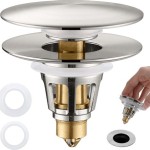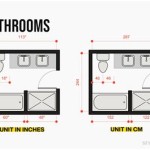How Much To Build A Bathroom In A Garage
Adding a bathroom to a garage can significantly increase a property's functionality and value. It provides convenience for various uses, such as a workshop, home gym, or potential conversion into an accessory dwelling unit (ADU). However, understanding the costs involved is crucial for planning and budgeting effectively. The total expense depends on several factors, ranging from the complexity of plumbing and electrical work to the choice of materials and finishes.
This article delves into the various cost components associated with building a bathroom in a garage, providing a comprehensive overview of the expenses involved. By understanding these factors, homeowners can better estimate the potential investment required and make informed decisions about their project.
Plumbing Costs: A Major Factor
Plumbing is typically a significant expense when adding a bathroom to a garage. The primary factor influencing plumbing costs is the proximity of existing plumbing lines. If the garage is located far from the main plumbing system, extending supply lines and drainage pipes can be more complex and expensive. This involves trenching, running pipes under the slab (if present), or through walls, which requires specialized labor and materials.
The cost of plumbing installation encompasses several elements. This includes running water lines for the sink, toilet, and shower (if included). It also involves installing drainage pipes to carry wastewater away from these fixtures to the main sewer line or septic system. The type of piping used (e.g., copper, PEX, PVC) can also affect the overall cost, with copper generally being the most expensive option due to its durability and longevity. PEX is a flexible plastic material gainng popularity due to its cost-effectiveness and ease of installation.
Permitting and inspection fees related to plumbing also contribute to the total cost. Most municipalities require permits for plumbing work to ensure compliance with building codes and safety standards. Inspections are then conducted to verify that the work meets these requirements. These fees can vary depending on the location and scope of the project.
In cases where the garage slab needs to be cut and excavated for plumbing, the cost will further increase. Concrete cutting and removal require specialized equipment and labor. After the plumbing is installed, the concrete needs to be repaired and refinished, adding to the overall project cost. The more extensive the concrete work, the higher the expense.
Considering all these factors, plumbing costs can range from several thousand dollars to significantly more, depending on the complexity of the installation. Obtaining multiple quotes from licensed plumbers is recommended to get an accurate estimate for the specific project.
Electrical Work and Wiring
Electrical work is another essential aspect of adding a bathroom to a garage. A bathroom requires adequate lighting, ventilation (exhaust fan), and power outlets for various appliances and devices. The existing electrical panel in the garage might need to be upgraded to accommodate the additional electrical load, especially if the garage is only wired for basic lighting and a few outlets.
The cost of electrical work includes running new wiring from the main electrical panel to the bathroom location. This involves installing new circuits specifically for the bathroom, ensuring they meet the required amperage and voltage. Ground fault circuit interrupters (GFCIs) are required for outlets near water sources to prevent electrical shock, adding to the safety and cost of the installation.
Installation of lighting fixtures, such as overhead lights, vanity lights, and possibly recessed lighting, also contributes to the electrical cost. The type of fixtures chosen can significantly influence the overall expense, with more elaborate or energy-efficient options typically costing more. Additionally, the installation of an exhaust fan is necessary to remove moisture and prevent mold growth in the bathroom. This requires wiring and ductwork to vent the fan to the exterior of the garage.
Similar to plumbing, electrical work requires permits and inspections to ensure compliance with building codes and safety standards. These fees are an additional cost that needs to be factored into the budget. Hiring a licensed electrician is crucial to ensure the electrical work is done safely and correctly, avoiding potential hazards and code violations. Unlicensed electrical work can result in costly fines and safety risks.
The cost of electrical work can range significantly depending on the scope of the project and the complexity of the wiring. Upgrading the electrical panel, installing new circuits, and adding required safety features can push the costs higher. Obtaining quotes from multiple licensed electricians is recommended to get an accurate estimate.
Materials and Fixtures: Choices Impact Costs
The choice of materials and fixtures plays a crucial role in determining the overall cost of building a bathroom in a garage. From framing and insulation to tiling and bathroom fixtures, the selection of materials and finishes can significantly impact the final expense. Opting for high-end materials and designer fixtures will naturally increase the cost, while more budget-friendly options can help keep the project within a reasonable budget.
Framing and insulation are essential components of the bathroom structure. If the garage does not have existing walls or if the existing walls need to be modified, framing will be required to create the bathroom enclosure. Insulation is necessary to maintain a comfortable temperature and reduce energy costs. The type of insulation used (e.g., fiberglass, spray foam) can affect the overall cost.
The selection of bathroom fixtures, such as the toilet, sink, shower, and faucets, can significantly impact the overall expense. Toilets range in price from basic models to high-efficiency, dual-flush options. Sinks come in various styles, including pedestal sinks, vanity sinks, and wall-mounted sinks, each with different price points. Showers can range from simple prefabricated units to custom-tiled enclosures, with costs varying accordingly.
Tiling is another significant cost factor in bathroom construction. The choice of tile (e.g., ceramic, porcelain, stone) and the area to be tiled (e.g., floor, walls, shower) will influence the overall expense. Installation costs for tiling can also vary depending on the complexity of the pattern and the size of the tiles. Natural stone tiles tend to be more expensive than ceramic or porcelain options, both in terms of material cost and installation.
Other materials and finishes to consider include paint, flooring (if not using tile throughout), and accessories such as mirrors, towel racks, and lighting fixtures. The quality and style of these items can also affect the overall cost of the bathroom renovation. Choosing durable, long-lasting materials can help reduce future maintenance costs.
Careful planning and selection of materials can help control the overall cost of the bathroom project. Balancing aesthetics with budget considerations is crucial to creating a functional and visually appealing bathroom without breaking the bank. Shopping around and comparing prices from different suppliers can also help optimize the budget.
Beyond these primary cost components, there are often additional expenses that homeowners should anticipate. These can include demolition of existing structures, waste removal, and unexpected repairs uncovered during the project. It's prudent to set aside a contingency fund to cover these unforeseen costs to avoid budget overruns. The size of the contingency fund typically ranges from 10% to 20% of the total project budget.
The overall cost can also be affected by the location of the property. Labor costs and material prices can vary significantly depending on the region. Metropolitan areas tend to have higher labor costs compared to rural areas. Obtaining multiple quotes from local contractors is essential to get an accurate estimate for the specific location.
Finally, the decision to hire a general contractor versus managing the project independently can impact the overall cost. A general contractor typically charges a fee for their services, which can add to the total expense. However, a general contractor can also streamline the project, coordinate subcontractors, and ensure the work is done to code, potentially saving time and money in the long run. If the homeowner possesses project management expertise and is comfortable coordinating various trades, managing the project independently can be a viable option, but it requires a significant time commitment and understanding of construction processes.

Building A Bathroom In My Garage

Building A Small Bathroom In The Garage Full Time Lapse

Cost To Add A Bathroom 2024 Guide Forbes Home

How Much Does It Cost To Add A Bathroom 2024 Data

Garage Renos Add Convert Build A Bathroom Toilet Shower

Fixr Com Cost To Remodel A Garage Conversion

Diy How To Turn A Garage Into Studio Apartment With Shiplap Metal

Average Cost To Build A Garage Forbes Home

Fixr Com Cost To Build A Detached Garage 2 Car

Building A Bathroom From Scratch Timelapse
Related Posts







